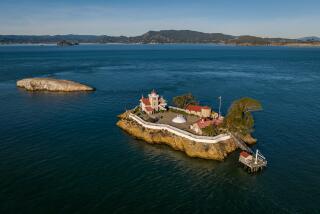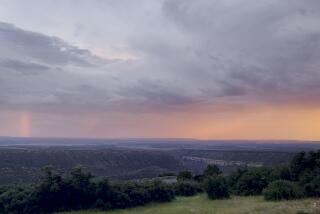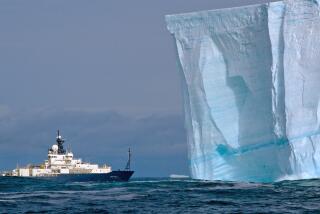Twin Passions for Nature, Adventure Put Woman on Top of World
- Share via
CANASTOTA, N.Y. — Clumps of ice make a patchwork design on Canada’s Lake Hazen. Mirrored in the frosty water is the looming image of Barbeau Peak.
Nearby, zigzagging over the soft top of a sun-braised glacier, an arctic hare scurries upright on its two hind feet, trying to outmaneuver a pack of pursuing wolves. The wind pushes persistently, but at the top of the world, there are few sounds for it to carry.
When Mary Kunzler-Larmann thinks about the northern paradise she has found on Canada’s Ellesmere Island, she wonders why she didn’t surrender sooner to her love of the outdoors.
“It’s a place where I belong,” said the 55-year-old Kunzler-Larmann, who spends two months every summer leading small tours 1,000 miles above the Arctic Circle to Ellesmere Island National Park Reserve.
It was misfortune that allowed her to follow her passion.
For 27 years, Kunzler-Larmann worked in an office as an administrative services manager for a Syracuse manufacturing company. On her vacations, she rushed off for the wilderness--sometimes by herself, which sparked worried whispers from her more conservative co-workers.
Then, in 1991, Kunzler-Larmann found herself “downsized” and out of a job.
“When I first got laid off, I suddenly realized, the knee-jerk reaction is to go back and find the same kind of job and get yourself back to the level where you were,” said Kunzler-Larmann, sitting in her office in the basement of her New York home amid a small library of Arctic books, maps of northern Canada and a modest collection of polar treasures.
Among the many photos on the wall is one of a kayaker surprised by the splash of a whale’s tail just a few feet away. It’s one of her favorites.
“I asked myself, why am I doing this if I’ve been complaining about it all these years?” she said.
Now, when she isn’t taking her husband to see the Grand Canyon or helping local planners develop a new hiking trail system, Kunzler-Larmann is spending her time planning, organizing and recruiting for northern expeditions as a private contractor for Canada North Outfitting of Almonte, Ontario.
It takes 10 months of legwork to arrange the two 16-day trips she guides each July and August. The summer never comes soon enough, she said.
“I grew up in the country,” Kunzler-Larmann said. “I grew up on a dairy farm in the Catskills. I guess it was something in the bloodstream. My family has stories about my father having to drag me out of the woods at night in the dark.”
Her father wanted seven sons. Instead, he got one handful of daughter, who would later learn to fly airplanes.
Growing up, the 5-foot-2, 110-pound Kunzler-Larmann found hiking, canoeing and outdoor activities more to her liking than organized sports. When she found the national parks of the American West spilling over with tourists, she sought out less crowded environs in Alaska and Canada’s Northwest Territories.
Eleven years ago, her self-reliance, adventurous spirit and love of flying caught Al Larmann’s attention. Fifteen years her senior, he is mostly a spectator to his wife’s exploits, although the couple did visit the Grand Canyon together recently. Mary made three trips to the bottom while Al stayed up on the rim.
“Much of what Mary does requires individual effort. She derives a great deal of personal satisfaction from it,” said Larmann, who still flies in the Civil Air Patrol.
“I understand this lure of the outdoors, but in my case I don’t like to run up and down mountains,” he said. “People like Mary love the outdoors. She draws her strength from it.”
It is the test of surviving on her own resources that lures Kunzler-Larmann back to the 23,420-square-mile preserve each summer, she said. Although temperatures reach the 30s and 40s, Ellesmere is a treeless, wind-swept polar desert.
“You have to be totally self-sufficient,” she said. “All your food. All your fuel. Your shelter. You have it with you, or you don’t have it.
“It’s supposed to be a vacation and fun. You don’t want it to be a struggle for survival. But there’s just such a higher element of risk. It’s a place that can test you in many ways.”
While nunataks (peaks protruding through the icecap), fiords and glaciers combine for a splendorous view, there are few people around to see them. The only permanent settlement on Ellesmere, which covers 82,100 square miles, is Grise Ford, an Inuit village with approximately 130 residents, at the island’s southern tip.
In northern Ellesmere, there’s a Canadian military outpost, a manned weather station and a lot of empty land. The nearest fuel is a 4 1/2-hour flight away. The nearest Canadian hospital is 1,000 miles away; it’s quicker to fly to Russia.
“It’s an extremely isolated place, and that’s the biggest problem,” said Barry Troke, the park’s senior warden. “In Ellesmere, there is nothing. It’s total wilderness, and that’s the way it’s meant to be.”
The park rules require every camper to have a two-way radio. River crossings, glacier crossings, rock slides, wolves and musk oxen: All present a grave danger in a place so removed, Troke said.
Last year, 50 so-called “adventure tourists” visited the park, including two dozen with Kunzler-Larmann. Once there, travelers could accompany her on guided tours or go off on their own to hike, fish, canoe, hunt for archeological treasures, perform biological or geological research or simply photograph the landscape and wildlife.
While Kunzler-Larmann is of small stature and quiet voice, her confidence and knowledge quickly settle any anxious tourists as they first peer across the unending solitude.
“She makes it a less threatening place. She knows the dangers. She knows the beauty,” said Susan Pfeister, who left her two teenage sons at home last summer to go north with Kunzler-Larmann.
“Mary fits in the wilderness,” she said. “You can tell that right away.”
More to Read
Sign up for The Wild
We’ll help you find the best places to hike, bike and run, as well as the perfect silent spots for meditation and yoga.
You may occasionally receive promotional content from the Los Angeles Times.






